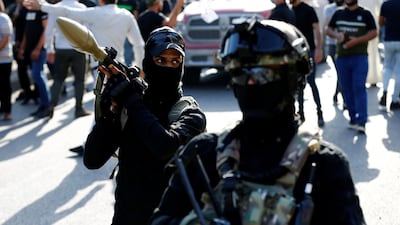A political class largely allied with Iranian-backed militias is showing no qualms about using deadly violence against the mass protest movement sweeping Iraq, heightening the risk of internecine conflict.
The prospect of another civil war in Iraq, this time among the country’s majority Shiites after the defeat of ISIS, could be a strategic nightmare for Iran, as well as the US.
The two outside powers had invested the most in the ruling, Shiite dominated, elite that now controls the fifth-largest oil reserves in the world.
The demonstrations represent the deepest threat to the Shiite political class since the ascendency of the sect to power, made possible by the US-led invasion that toppled Saddam Hussein in 2003.
Leaders of Shiite parties and militias have spent the last 16 years promising to rectify repression the sect had suffered under Saddam and defeating what they regard as Sunni extremism.
Many have not shied away from turning their guns against the most dispossessed of their own.
The fault lines hardened after more than 40 demonstrators were killed on Friday in protests across the Arab regions in central and south of Iraq that had paused for a Shiite religious occasion known as Arbaeen. The Kurdish-ruled north of the country has remained outside of the equation.
Sunnis have also joined the protest movement, especially in Baghdad, as discontent with the Shiite sectarian militia appeared to manifest itself nationwide. But the bulk of casualties have been Shiites.
An independent Shiite cleric supporting the protest movement, who did not want to be identified to preserve his safety, told The National that he had seen close quarter firing on the demonstrators, more recently in the centre of Baghdad.
“The killings, in Baghdad and in Basra and elsewhere, amount to summary executions. The fact that the victims are Shiites did not help them,” he said.
“Those doing the killings have made the demonstrators American agents, or Israeli, or a brainwashed mob. They have adopted the same mentality as Saddam and the Baath. But in doing so they have opened Iraq to all possibilities. The demonstrators keep coming back.”
The authorities had promised before the lull to investigate the killing of 150 protestors at the eruption of the uprising earlier this month.
But the most violent response has been reserved to members of the Shiite underclass who had initiated the revolt against the political order in the south of the country, where most of Iraq’s oil is produced.
Many of the deaths on Friday were reported in the southern cities of Nasiriyah, the hometown of Prime Minister Adel Abdel Mahdi, and in Samawa, Amara, Diwaniyah and Basra, the largest city in the south, near the Shat Al Arab waterway.
Members of Asaib Ahl Al Haq, one of ideologically driven Shiite militias backed by Iran, reportedly fired at protesters who had marched on its headquarters in Nasiriyah, killing at least nine demonstrators.
In Diwaniyah, 12 demonstrators were burnt to death or died from smoke when they were caught inside the headquarters of the Badr militia, which security specialists in the region consider Iran’s striking arm, as other protesters set fire to the compound, not knowing that their co-protesters were inside.
The Iraqi cleric, who has a network of supporters across the country, said some of the protesters appear to have been pushed by some militia to settle scores with other paramilitary groups.
Some, such as Moqtada Al Sadr, a Shiite leader who presents himself as anti-establishment, has promised to protect the demonstrators, but the independent cleric said this may be a cover to improve Mr Sadr’s position in the system.
Mr Sadr has not acted to push his earlier demands for the government to resign and for internationally supervised elections to take place.
Mr Sadr, however, is one of the few Iraqi figures seen in the street as not fully allied with Iran, having sought links with Gulf States, and promoted what he regards as an Iraqi nationalist agenda.
In decades of conflict with Iran that culminated in the 1980-1988 Iraq-Iran war, Saddam portrayed Iraq as the eastern flank of the Arab world, or the bulwark against Iranian expansion westwards, a position that ended with his toppling.
The US may also have little interest in seeing the current regime in Baghdad change, with attacks in recent months on US bases and interests, blamed on the pro-Iranian militias, subsiding.
“Abdel Mahdi is a facade that suits all. He might go but neither the US nor Iran want any real change,” said the cleric.
That leaves slim hope for the protest movement, unless an imposing national figure emerges from its ranks, or Mr Sadr rises to the occasion.

